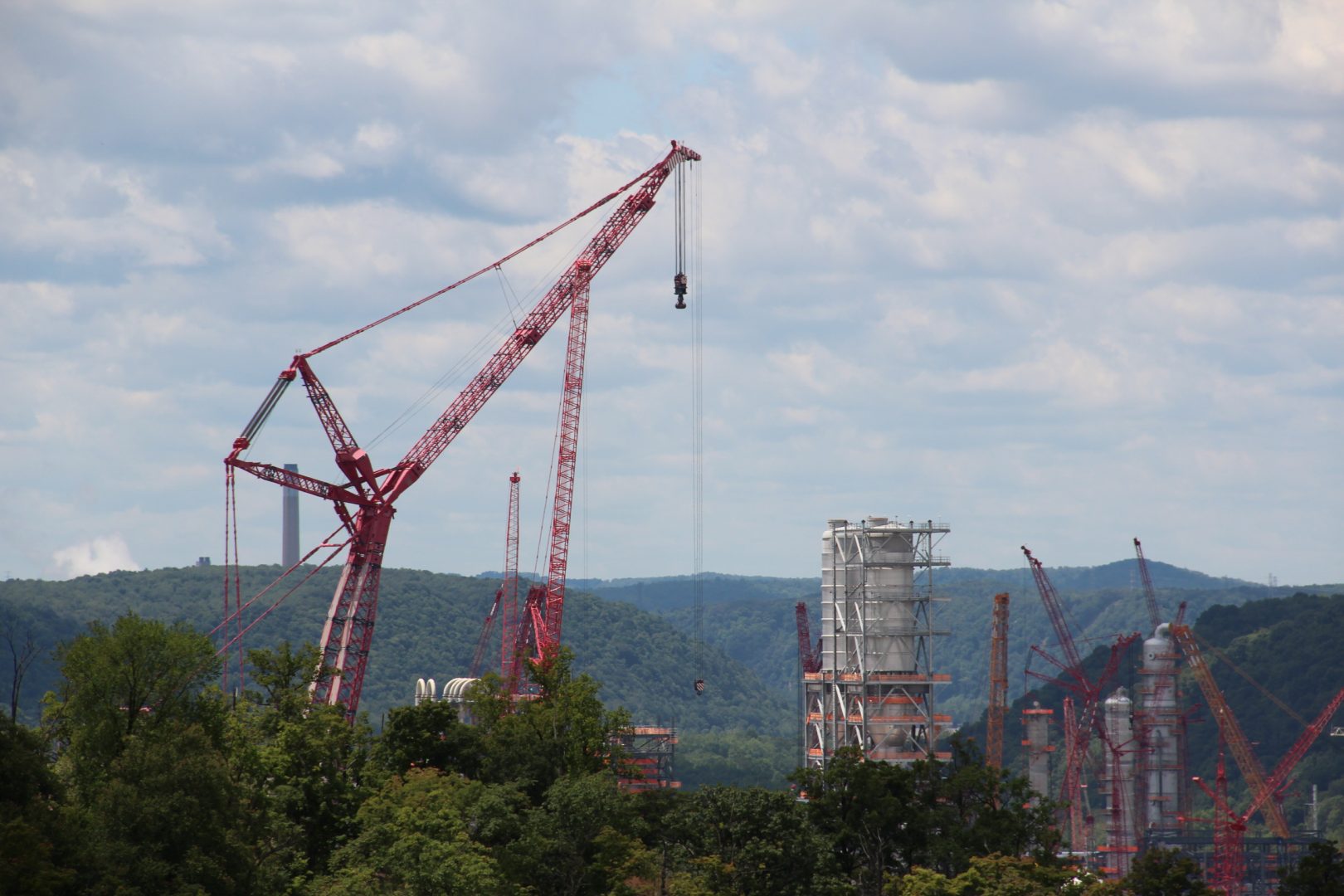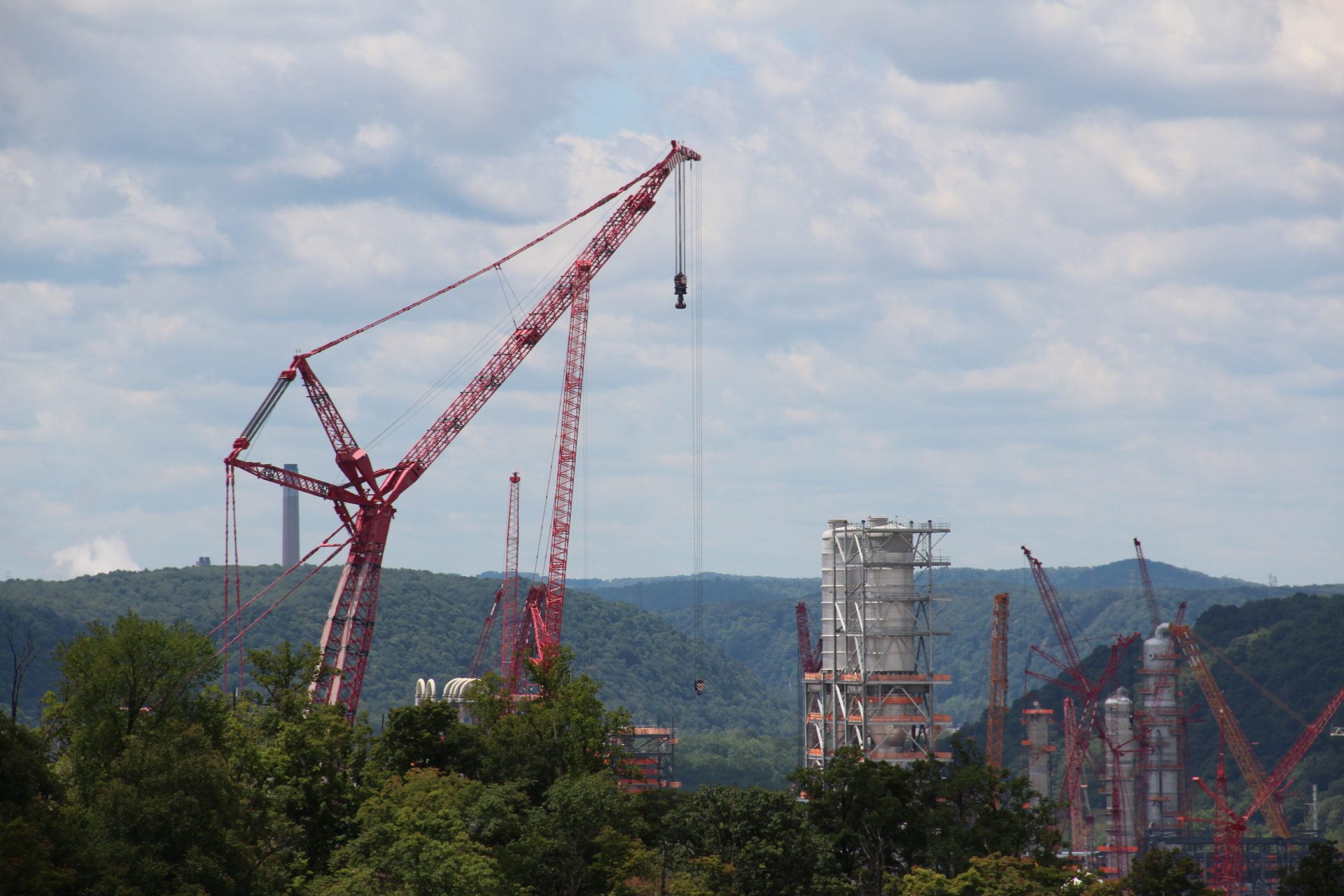
Shell's ethane cracker under construction in June, 2019 in Beaver County, Pa.
Reid R. Frazier / StateImpact Pennsylvania


Shell's ethane cracker under construction in June, 2019 in Beaver County, Pa.
Reid R. Frazier / StateImpact Pennsylvania

Reid R. Frazier / StateImpact Pennsylvania
Shell's ethane cracker under construction in June, 2019 in Beaver County, Pa.

Reid R. Frazier / StateImpact Pennsylvania
Shell’s ethane cracker under construction in June 2019 in Beaver County, Pa.
Shell officials told a group of residents Thursday night that they are nearing completion on a pipeline that will feed the Beaver County ethane cracker. They also said the plant is in peak construction mode, with 6,000 craft workers working on the site.
The update came at a public presentation put on by the company in Monaca, Beaver County. During the presentation, no photography or recording was allowed by company organizers.
Shell officials told the audience they’ve hired half of the 600 people who will work at the plant once it’s built. They gave presentations on the plastic products the plant will ultimately produce, charitable giving the company has begun in the region, and a new initiative the company will undertake to increase recycling.
The format of the meeting disappointed some activists who attended.
“It’s billed as a community meeting, but it’s not a community meeting because there’s no interaction between community members allowed during the program,” said Terrie Baumgardner, of Beaver County Marcellus Awareness Community. “Questions are siloed to tables where there are company experts.”
Michael Marr, a Shell representative, said the company has been holding the meetings periodically since 2014.
“We like to come and give people the opportunity to engage directly with us,” he said. “It gives us the opportunity to come and hear about what they have on their mind, give them information, answer their questions to the extent we can.”
The meeting attracted about 30 area residents, most of whom were curious about the project, which received $1.65 billion in tax credits from the state.
Erin Kelley, of nearby Mayview Heights, said she’s seen a change in the community since construction got underway.
“A lot of folks are making money that they’ve never been able to make before, making family sustainable incomes, (which) we’re excited to see here in Beaver County,” she said. Kelley’s father is a union steamfitter who retired after working at the plant.
Kelley said she was also concerned about the plant’s environmental footprint. It will be the region’s top emitter of volatile organic compounds, and will also emit hazardous air pollutants.
“I want to see some transparent disclosures about what the environmental impacts are going to be,” she said.
Dave Stewart of Monaca said he was very concerned about air pollution.
“If you look at where they put their plants, it’s always in economically depressed very blue-collar areas, and you look at long-term health effects of that — it’s very bad,” Stewart said.
Stewart said he is also worried about the plant’s impacts on climate change — it is permitted to emit as much carbon dioxide as 400,000 cars every year — and the impact the nearly 2 million tons of plastics it will produce. “Plastic is the last thing we need in the world. There’s so much plastic in the world’s oceans right now.”
But Steve Krizan said the plant would be a net positive for the area. Krizan, a general foreman with the Teamsters, has worked at the plant for the past two years. He said the money is good, and the job is challenging. He says the plant has brought a lot of business opportunities to Beaver County.
“It has changed. It’s brought Beaver County out of the ruts from the olden days, the steel business, things like that,” Krizan said. “It’s a good change.”
StateImpact Pennsylvania is a collaboration among WITF, WHYY, and the Allegheny Front. Reporters Reid Frazier, Rachel McDevitt and Susan Phillips cover the commonwealth’s energy economy. Read their reports on this site, and hear them on public radio stations across Pennsylvania.
(listed by story count)
StateImpact Pennsylvania is a collaboration among WITF, WHYY, and the Allegheny Front. Reporters Reid Frazier, Rachel McDevitt and Susan Phillips cover the commonwealth’s energy economy. Read their reports on this site, and hear them on public radio stations across Pennsylvania.
Climate Solutions, a collaboration of news organizations, educational institutions and a theater company, uses engagement, education and storytelling to help central Pennsylvanians toward climate change literacy, resilience and adaptation. Our work will amplify how people are finding solutions to the challenges presented by a warming world.